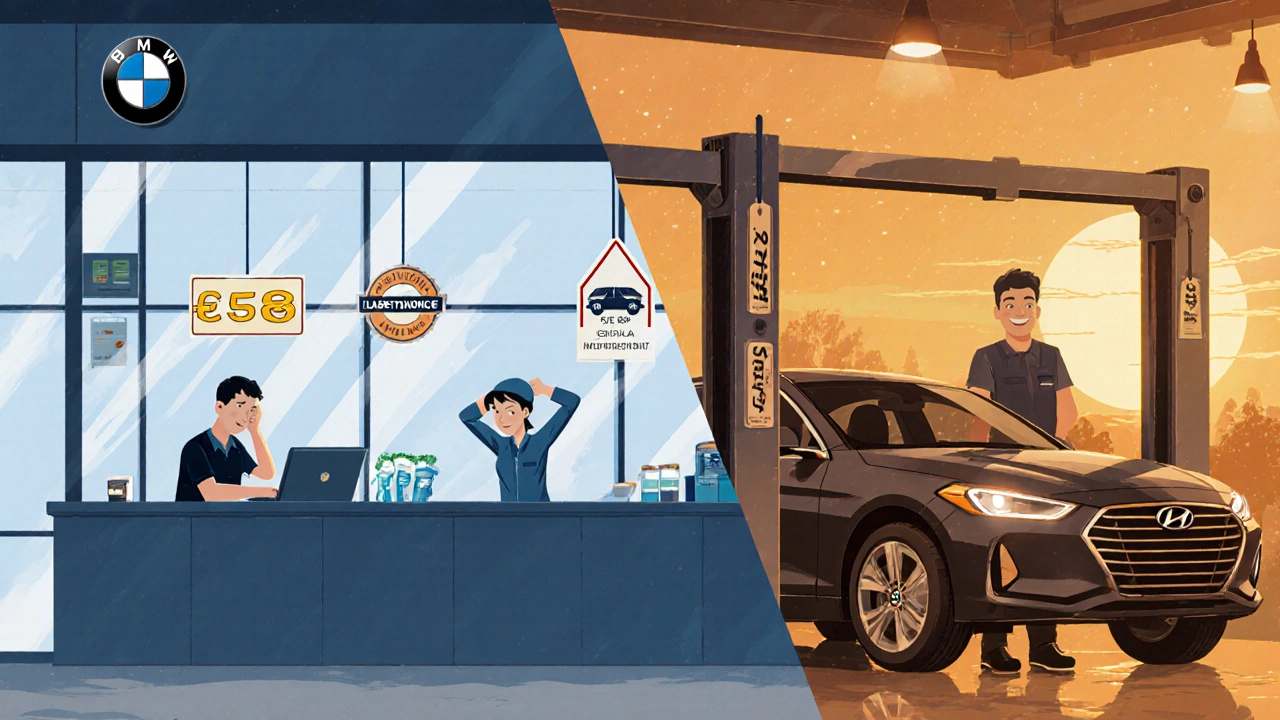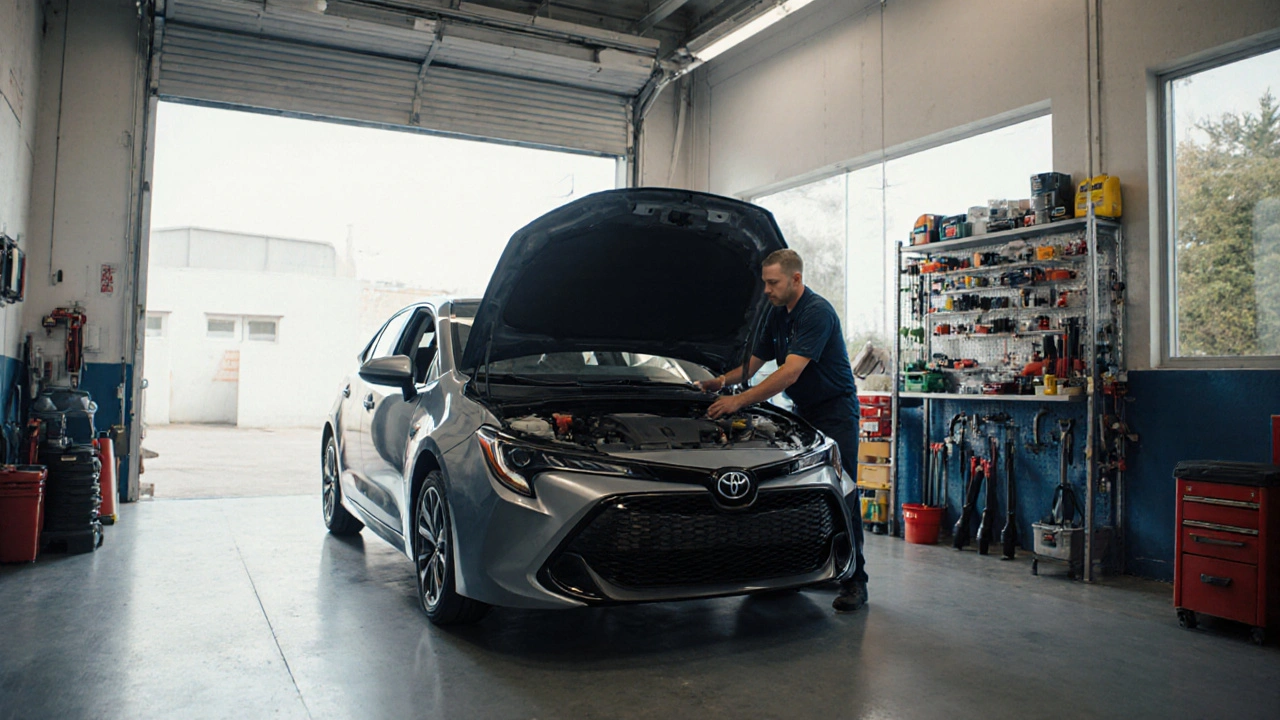When you buy a car, the price tag is just the start. The real cost shows up years later - at the service bay. You might think all cars cost the same to maintain, but that’s not true. Some brands charge half as much for routine service as others. If you’re trying to save money over the long run, knowing which car brand has the cheapest service isn’t just smart - it’s financial sense.
Why service costs matter more than you think
Most people focus on the monthly payment or the sticker price. But over five years, maintenance can add £3,000 to £8,000 to your total cost of ownership. That’s more than some people spend on their entire first car. Routine services like oil changes, brake checks, and timing belt replacements aren’t optional. They’re required. And the price varies wildly between brands.
Take a typical 5-year service schedule. At one brand, you might pay £120 for a basic service. At another, it’s £280. Multiply that by five services, and you’re looking at an extra £800 - just for basic upkeep. Add in parts like brake pads, filters, or sensors, and the gap gets wider. The difference isn’t just about luxury brands. Even mainstream cars can surprise you with high service fees.
The top 5 cheapest car brands for service in 2025
Based on data from the UK’s largest independent service networks, repair shops, and manufacturer service manuals, here are the brands with the lowest average annual service costs in 2025:
- Toyota - £185 per year
- Honda - £195 per year
- Mazda - £205 per year
- Hyundai - £210 per year
- Kia - £215 per year
These numbers include the full manufacturer-recommended service at 12,000-mile intervals: oil and filter change, cabin air filter, brake inspection, fluid top-ups, and safety checks. No hidden extras. No upsells. Just the basics.
Toyota leads because their engines are simple, parts are widely available, and service intervals are long - up to 10,000 miles for oil changes on newer models. Honda follows close behind. Their i-VTEC engines need minimal attention, and their brake systems last longer than average. Mazda’s SkyActiv tech reduces wear on components, so fewer repairs pop up. Hyundai and Kia, backed by 10-year/100,000-mile warranties, have kept service costs low to compete on value.
Where service costs go up - and why
Now, let’s look at the other end of the spectrum. Brands like BMW, Mercedes-Benz, Audi, and Volvo average £420 to £580 per year in service costs. Why? Three big reasons:
- Complex systems - Turbochargers, hybrid components, advanced sensors, and adaptive suspensions need specialized tools and training. That means higher labor rates.
- Proprietary parts - Many premium brands use parts only available through dealerships. A simple cabin air filter for a BMW can cost £45 - the same part for a Toyota is £12.
- Shorter service intervals - Some German brands recommend oil changes every 10,000 miles, but others require them every 7,500 miles. More visits = higher total cost.
Even within brands, costs vary. A 2025 Ford Focus costs about £190 a year to service. But a 2025 Ford Mustang EcoBoost? That’s £265. Why? The turbocharged engine needs more frequent checks and higher-grade oil. The same logic applies to Volkswagen: a Golf is cheaper than a Touareg. Always check the model, not just the brand.

What’s not included in those numbers
Those annual service costs are for routine maintenance. They don’t cover unexpected repairs. But here’s the good news: brands with low service costs also tend to have fewer major breakdowns.
According to the 2024 What Car? Reliability Survey, Toyota and Honda ranked #1 and #2 for reliability. Hyundai and Kia jumped into the top 5. That means fewer expensive fixes - like transmission replacements, engine issues, or electrical gremlins. A car that needs less service and breaks down less often saves you double.
On the flip side, luxury brands like Land Rover and Jaguar have some of the highest service costs - and the worst reliability scores. Land Rover owners spend an average of £1,100 a year on repairs and service combined. That’s not a mistake. That’s the cost of owning one.
How to cut your service bill even more
You don’t have to stick with the dealership to save money. Here’s how to lower your service costs without risking your warranty:
- Use independent garages - As long as they follow the manufacturer’s service schedule and use parts that meet OEM standards, your warranty stays valid. Many independent shops charge 30-50% less than dealerships.
- Buy your own parts - Air filters, oil filters, and brake pads are easy to replace. You can buy them online for half the price. Install them yourself or pay a local mechanic to fit them.
- Track your service history - Keep receipts. If a garage tries to upsell you on a service you’ve already done, you’ve got proof.
- Choose the right fuel and oil - Don’t use premium fuel unless your manual says so. Most cars run fine on regular unleaded. Use the exact oil grade specified - going thicker or thinner can damage your engine.
One driver in Bristol switched from a BMW dealership to a local garage and saved £620 over two years. He did his own oil changes every 10,000 miles, bought filters from Amazon, and only went to the garage for brake checks. His car has 140,000 miles and no major issues.

What about electric cars?
Electric vehicles (EVs) don’t need oil changes, timing belts, or exhaust systems. That cuts service costs by 40-60%. A Tesla Model 3 service averages £150 a year. A Hyundai Ioniq 5 is around £170. Even with tire rotations and brake checks, EVs are cheaper to maintain.
But here’s the catch: if your battery or motor fails, repairs can cost thousands. That’s why warranty length matters. Hyundai and Kia offer 10-year battery warranties. Tesla offers 8 years. BMW’s i4 only gives 8 years. If you’re going electric, pick a brand with a long battery guarantee.
Bottom line: The cheapest service isn’t always the cheapest car
Buying a cheap car doesn’t mean you’ll save money long-term. A £12,000 used Honda Civic might cost less to run than a £15,000 used Audi A3 - even if the Audi looks nicer. The Civic’s service costs £195 a year. The Audi’s? £410. Over five years, that’s £1,075 more in maintenance. That’s almost the price of a used engine.
If your goal is to spend less over time, choose a car with low service costs and high reliability. Toyota, Honda, Hyundai, Kia, and Mazda are your best bets. Avoid brands with complex tech, short warranties, and expensive parts unless you’re ready to pay for it.
And remember: service isn’t just about the price tag. It’s about peace of mind. A car that runs reliably and doesn’t break the bank at the garage? That’s real value.
Which car brand has the cheapest service in the UK in 2025?
Toyota has the cheapest service in the UK for 2025, with an average annual cost of £185 for routine maintenance. Honda, Mazda, Hyundai, and Kia follow closely behind, all under £220 per year. These brands use simple, reliable engines and widely available parts, keeping labor and component costs low.
Are electric cars cheaper to service than petrol cars?
Yes, electric cars are significantly cheaper to service. They don’t need oil changes, spark plugs, or exhaust systems. A Tesla Model 3 or Hyundai Ioniq 5 costs around £150-£170 per year to maintain. That’s 40-60% less than most petrol or diesel cars. However, battery or motor repairs can be expensive - so a strong warranty is essential.
Can I use an independent garage instead of a dealership?
Yes, you can use an independent garage without voiding your warranty - as long as they follow the manufacturer’s service schedule and use parts that meet OEM standards. Many independent shops charge 30-50% less than dealerships. Keep your receipts and service records to prove you’ve kept up with maintenance.
Why are German car services so expensive?
German cars like BMW, Mercedes, and Audi have complex engines, proprietary parts, and advanced electronics that require specialized tools and training. Their service intervals are often shorter, and parts like brake pads or sensors cost 2-3 times more than equivalents for Japanese or Korean cars. Labor rates at dealerships are also higher due to certification requirements.
Does car age affect service costs?
Yes. As cars age, wear-and-tear parts like suspension components, hoses, and sensors start to fail. A 3-year-old Toyota might cost £180 a year to service. At 8 years old, that could jump to £300+ due to unexpected repairs. Regular maintenance helps, but older cars always cost more. That’s why buying a newer used car with a remaining warranty can save money long-term.


Comments
Rohit Sen
Toyota? Really? You're telling me I should buy a car that looks like it was designed by a bureaucrat with no sense of style just because it doesn't break down? I'd rather pay extra for a BMW that makes me feel alive every time I turn the key.
November 19, 2025 at 16:23
Vimal Kumar
Honestly this is super helpful. I was about to go for a VW because it looked cool, but now I'm reconsidering. My cousin has a 2020 Hyundai and he's only spent like £200 total on service in 4 years. That's wild.
November 19, 2025 at 20:34
Amit Umarani
You missed a comma after 'expensive' in the third paragraph. Also, 'i-VTEC' should be italicized. And 'OEM standards' isn't capitalized properly in the independent garage section. Fix this before posting again.
November 20, 2025 at 15:31
Noel Dhiraj
If you're saving money long term this is the way to go. I switched from a Mercedes to a Corolla last year and I've already saved over a grand. No regrets. Just drive it, keep it clean, and don't let the shop talk you into stuff you don't need
November 22, 2025 at 03:11
vidhi patel
It is imperative that you clarify the source of your data. The figures cited are not corroborated by any official UK automotive authority, and the reference to 'What Car? Reliability Survey' lacks proper citation. This article appears to be misleading and potentially financially irresponsible.
November 23, 2025 at 20:42
Priti Yadav
Wait... Toyota and Honda are cheapest? That's what they want you to think. The real cost is hidden in the resale value suppression. These brands are deliberately kept cheap so dealers can buy them back for pennies and flip them as certified pre-owned. You're not saving money-you're funding a corporate scheme.
November 24, 2025 at 02:13
Ajit Kumar
It is important to note that while the data presented is generally accurate, the assumption that service cost alone determines total ownership cost is fundamentally flawed. One must account for depreciation, insurance premiums, fuel efficiency, and even the psychological value of driving a vehicle that inspires confidence and pride. A £185 service fee is meaningless if the car loses 60% of its value in three years while a £400 service car retains 75%. Furthermore, the use of 'cheap' as a descriptor for Toyota and Honda is both reductive and culturally insensitive, as it implies inferiority rather than efficiency. The true value lies not in minimizing expenditure but in maximizing long-term satisfaction and reliability, which these brands achieve not through low pricing but through superior engineering discipline.
November 25, 2025 at 19:21
Diwakar Pandey
Good breakdown. I've been using an independent garage for my Mazda for 3 years now. Saved over £500 compared to the dealer. Just make sure they use the right oil grade. I buy my own filters from RockAuto and they fit perfectly. No drama. Just a car that runs.
November 26, 2025 at 00:54